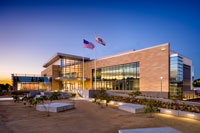

Green Leadership
Jun 3, 2011 3:59 PM,
By Dan Daley
InfoComm Energy Management Standards in Action
More on Green AV
10 Minutes With Project Green AV Founder & Director Gina Sansivero
The systems installed at East Contra Costa Courthouse in Martinez, Calif., took the auto shutoff product and system features that are arbitrarily set to a
predetermined time further by programming in real-world variables. The ROI was determined by measuring the energy draw, in watts, on the system
when it was fully on, then measuring the differences in power draw as each component would go into standby mode and finally into a fully off state.
Green AV sounds good, but like most buzzwords, it’s ever in peril of being overwhelmed by its own hyperbole. That’s why when a group of AV professionals who also are members of Green AV Energy Management Standards Task Force saw an opportunity to test out its energy and cost-savings projections on a real-world project, they jumped at the chance. The East Contra Costa County Courthouse in Martinez, Calif., was under construction last year when Christopher Maione Associates—president of Christopher Maione Associates—and Steven Greenblatt—president of Control Concepts—joined forces with Jennifer Willard, supervising AV systems technical analyst for the Judicial Council of California Administrative Office of the Courts, who volunteered the new construction project as a proof of concept for metering and empirically calculating just how much can be saved with a valid green AV systems design.

“We’ve discussed the idea of return on investment and reducing energy consumption in the hypothetical sense for some time, but the California courts AV project offered an opportunity to apply them in a real-world situation,” Maione explains. Working with ICS Integration—which engineered, installed, programmed, and commissioned the Biamp Systems DSP and Crestron CP2E control systems for the systems integrator Digital Design—the team programmed the system in an experiment to validate what have been up until now theoretical return-on-investment projections. “The intent was to write an adjunct to the control system programming that would enable standby modes that could be engaged based on time of day, day of the week, the ability to sense occupancy of the room they were used in, and to use intelligent timers that would sense that as certain amounts of time elapsed without use, [the systems] would automatically back themselves into an off state,” Maione says.
As a state, California has taken a leading role in implementing energy efficient technologies. For instance, the 2010 CALGreen Building Standards Code
Code established statewide mandatory green building regulations for most new construction projects starting January 2011. Thus, it’s not surprising that the state court system, which is undergoing a huge capital infrastructure project that will add 41 new courthouses across the state, was inclined to participate in the ROI test. “We partner with InfoComm in helping develop AV system standards that can be used to educate and influence architects and builders about better ways to design buildings to be more energy efficient,” Willard says. “Being able to quantify the savings from efficient AV systems design will help cost effectiveness to operate and maintain these facilities, and those savings can be used to help fund other critical aspects of the courts’ operations in the future.”

The programming was relatively simple, Greenblatt says. “We can add this kind of control into any existing AV automation system that allows this kind of management to occur, and that also can do measurement of the energy use and present the data from it,” he says.
Jason Meyer, senior programmer for ICS, says usually a project’s conventional auto shutoff product and system features are arbitrarily set to a predetermined time at night, but this project took that a few steps further by programming real-world variables in. “We used some standard [programming macros] that would shutdown certain equipment off at 6 p.m., for example, but we also wrote more programming in that did things like monitor the gates on the microphones. When the gate didn’t hear any sound for more than 45 minutes, the control system would warn anyone in the room via a countdown on the Crestron V12 touchpanels that the Biamp audio amplifier and AV system will shut down, unless someone speaks or cancels the shutdown via the touchpanel,” Greenblatt says. Programming was also added for daylight harvesting and dimming lights to reduce lighting energy use.
Green Leadership
Jun 3, 2011 3:59 PM,
By Dan Daley
InfoComm Energy Management Standards in Action
More on Green AV
10 Minutes With Project Green AV Founder & Director Gina Sansivero

Figure 1. Crestron control system programmed to automatically transition to Standby mode when audio is not detected and to Off mode during nonbusiness hours.
Calculating the Savings
The actual assessment of the ROI was accomplished by measuring the energy draw, in watts, on the system when it was in a fully on state, then measuring the differences in power draw as each component would go into standby mode and finally into a fully off state. In addition, the calculations also took into account predictable periodic activity breaks during the court day schedule during which the equipment would have otherwise stayed on. They then applied local electrical rate costs to create a final ROI calculation (See Figure 2). The results were vivid; for instance, the power consumption savings using the auto standby mode for the projector in a single courtroom cut usage by 1,976 hours a year for a cost savings of nearly $1,900 annually. Other findings included the fact that displays represent 63.5 percent of overall power consumption savings, and that the uninterruptible power supply (UPS) is the highest power consuming component in the system and the least used.

Figure 2: Power consumption savings.
“These were conclusions that we had previously estimated that we could achieve, but this was a way to prove that the standards committee’s assumptions would come to fruition,” Maione says, adding that feedback from this exercise will contribute both to the furthering of the Green AV Systems Energy Management
Task Force’s aims and stimulate dialogue with manufacturers about adding more sophisticated auto sleep and shutdown modes to their products. “This was real life. This was the way to get it out of the ivory tower and into practice, in an actual working courtroom, to prove that green AV makes actual fiscal sense, especially at a time when states and counties are having financial issues. Green AV makes a difference.”
In addition to the ROI validation, the integrator also experienced his own green epiphany. ICS’s Jason Meyer says he’s become more aware of the economic benefits to clients of green designs and installations. “Yes, definitely, we’ve been trying to work more green angles into our designs and proposals. A recent project had motion sensors added for similar auto shutdown features, but the problem is that the AV integrator is usually brought into the project so late in the game that it’s hard to implement a lot of these ideas,” he says. “That’s a big issue. It would really make a big difference if we were able to bring these ideas in at the point where the electrical contractors are coming onto the project.”










